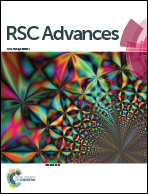Three-dimensional NiAl-mixed metal oxide film: preparation and capacitive deionization performances†
Abstract
A NiAl layered double hydroxide (NiAl-LDH) film was grown on the surface of a three-dimensional (3D) nickel foam by an in situ hydrothermal method using a nickel foam substrate as a nickel source, and boehmite (AlOOH) sol as an aluminium source. The 3D NiAl-mixed metal oxide (NiAl-MMO) film was obtained by calcining a NiAl-LDH film at 400 °C. The structure and surface morphology of the film samples were studied by X-ray diffraction, elemental analysis, room temperature Fourier transform infrared spectra and electron microscopy analysis. The results showed that NiAl-LDH nanoplatelets densely covered the surface of the nickel foam substrate. The 3D NiAl-MMO film obtained by calcining the NiAl-LDH film was used as capacitive deionization (CDI) electrode for electrosorption of NaCl in water. Under static test conditions, the electrosorption ratio for 0.01 mol L−1 NaCl is above 37.5%, while the electrosorptive capacity of the electrode is ultrahigh at about 81.2 mg g−1 electrode. For 15 rounds of electrosorption and desorption cycling, the decrease of the electrosorption ratio is very minimal, and the desorption ratio of NaCl is above 87.7%. It is shown that the NiAl-MMO film electrode can be used for the removal of NaCl in water.


 Please wait while we load your content...
Please wait while we load your content...